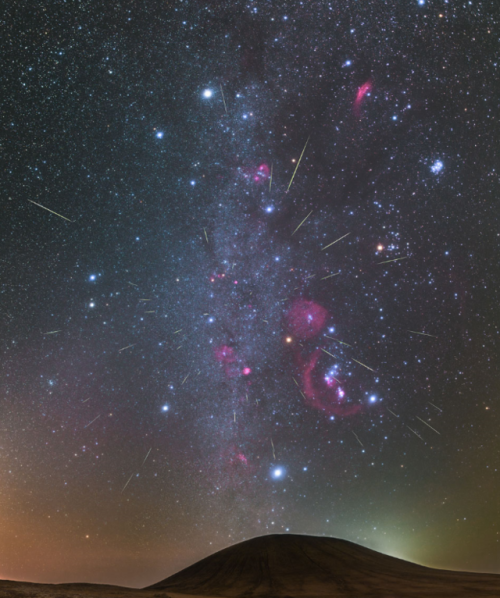Cosmicinsightz - Within The Cosmos

More Posts from Cosmicinsightz and Others

What caused this outburst of this star named V838 Mon? For reasons unknown, this star’s outer surface suddenly greatly expanded with the result that it became the brightest star in the entire Milky Way Galaxy in January 2002. Then, just as suddenly, it faded. A stellar flash like this had never been seen before – supernovas and novas expel matter out into space.
Although the V838 Mon flash appears to expel material into space, what is seen in the above GIF from the Hubble Space Telescope is actually an outwardly moving light echo of the bright flash.
In a light echo, light from the flash is reflected by successively more distant rings in the complex array of ambient interstellar dust that already surrounded the star. V838 Mon lies about 20,000 light years away toward the constellation of the unicorn (Monoceros), while the light echo above spans about six light years in diameter.
Credit: NASA, ESA
To discover more, visit: https://www.nasa.gov/multimedia/imagegallery/image_feature_2472.html

R Leporis, Vampire’s Star

Earth and Luna from the ISS

Flight Across The Universe

Orionids Meteors Over Wulan Hada Volcano





I couldn’t help myself on such a clear night. I revisited the Lagoon Nebula, Trifid Nebula, and M22 cluster, but I checked out the Saturn Nebula, which is smaller than I expected.

-
 nocturniss reblogged this · 1 month ago
nocturniss reblogged this · 1 month ago -
 nocturniss reblogged this · 1 year ago
nocturniss reblogged this · 1 year ago -
 conjuringcathexis liked this · 4 years ago
conjuringcathexis liked this · 4 years ago -
 fireinhersoulx reblogged this · 4 years ago
fireinhersoulx reblogged this · 4 years ago -
 otipemisiwak liked this · 4 years ago
otipemisiwak liked this · 4 years ago -
 elizabethbenitez2429 liked this · 4 years ago
elizabethbenitez2429 liked this · 4 years ago -
 schlafertrunken reblogged this · 4 years ago
schlafertrunken reblogged this · 4 years ago -
 amyliz-loves-books liked this · 4 years ago
amyliz-loves-books liked this · 4 years ago -
 trialed reblogged this · 4 years ago
trialed reblogged this · 4 years ago -
 hissleringolgesinde liked this · 4 years ago
hissleringolgesinde liked this · 4 years ago -
 ibraheem-obeid-0026 liked this · 4 years ago
ibraheem-obeid-0026 liked this · 4 years ago -
 uncannycreature liked this · 4 years ago
uncannycreature liked this · 4 years ago -
 bunklord reblogged this · 4 years ago
bunklord reblogged this · 4 years ago -
 permanentlysmol reblogged this · 4 years ago
permanentlysmol reblogged this · 4 years ago -
 jadenjonesiii reblogged this · 4 years ago
jadenjonesiii reblogged this · 4 years ago -
 hannahaubert reblogged this · 4 years ago
hannahaubert reblogged this · 4 years ago -
 whatever-ihadadream reblogged this · 4 years ago
whatever-ihadadream reblogged this · 4 years ago -
 jadikins reblogged this · 4 years ago
jadikins reblogged this · 4 years ago -
 treyshakira liked this · 4 years ago
treyshakira liked this · 4 years ago -
 cheleybelle reblogged this · 4 years ago
cheleybelle reblogged this · 4 years ago -
 cheleybelle liked this · 4 years ago
cheleybelle liked this · 4 years ago -
 twaktoe reblogged this · 4 years ago
twaktoe reblogged this · 4 years ago -
 twaktoe liked this · 4 years ago
twaktoe liked this · 4 years ago -
 uncl3mik3 reblogged this · 4 years ago
uncl3mik3 reblogged this · 4 years ago -
 lazy-boy06 liked this · 4 years ago
lazy-boy06 liked this · 4 years ago -
 groovy-vibez liked this · 4 years ago
groovy-vibez liked this · 4 years ago -
 pkelley74 liked this · 4 years ago
pkelley74 liked this · 4 years ago -
 theburningpanda reblogged this · 4 years ago
theburningpanda reblogged this · 4 years ago -
 theburningpanda liked this · 4 years ago
theburningpanda liked this · 4 years ago -
 lamontre liked this · 4 years ago
lamontre liked this · 4 years ago -
 catladyfreyja liked this · 4 years ago
catladyfreyja liked this · 4 years ago -
 thebigbadwolfally reblogged this · 4 years ago
thebigbadwolfally reblogged this · 4 years ago -
 thebigbadwolfally liked this · 4 years ago
thebigbadwolfally liked this · 4 years ago -
 whatiamtoyouisnotrealll liked this · 4 years ago
whatiamtoyouisnotrealll liked this · 4 years ago -
 monalisa--saperstein reblogged this · 4 years ago
monalisa--saperstein reblogged this · 4 years ago -
 illhelpwiththenightmares reblogged this · 4 years ago
illhelpwiththenightmares reblogged this · 4 years ago -
 hermionerose28 reblogged this · 4 years ago
hermionerose28 reblogged this · 4 years ago -
 hermionerose28 liked this · 4 years ago
hermionerose28 liked this · 4 years ago
a collection of all cosmic ephemeralities and phenomenons. a blog dedicated to exploring the vastness of the universe
66 posts
